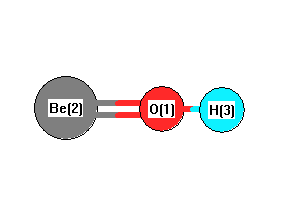Jump to
S1C2
Energy calculated at QCISD(T)=FULL/aug-cc-pVTZ
| | hartrees |
|---|
| Energy at 0K | -90.461257 |
| Energy at 298.15K | -90.461001 |
| HF Energy | -90.137986 |
| Nuclear repulsion energy | 17.704618 |
The energy at 298.15K was derived from the energy at 0K
and an integrated heat capacity that used the calculated vibrational frequencies.
Geometric Data calculated at QCISD(T)=FULL/aug-cc-pVTZ
Point Group is C∞v
Cartesians (Å)
| Atom |
x (Å) |
y (Å) |
z (Å) |
|---|
| O1 |
0.000 |
0.000 |
0.351 |
| Be2 |
0.000 |
0.000 |
-1.025 |
| H3 |
0.000 |
0.000 |
1.294 |
Atom - Atom Distances (Å)
| |
O1 |
Be2 |
H3 |
| O1 | | 1.3761 | 0.9436 |
Be2 | 1.3761 | | 2.3197 | H3 | 0.9436 | 2.3197 | |
 More geometry information
More geometry information
Calculated Bond Angles
| atom1 |
atom2 |
atom3 |
angle |
|
atom1 |
atom2 |
atom3 |
angle |
| Be2 |
O1 |
H3 |
180.000 |
|
Electronic energy levels
Charges, Dipole, Quadrupole and Polarizability
Jump to
S1C1
Energy calculated at QCISD(T)=FULL/aug-cc-pVTZ
| | hartrees |
|---|
| Energy at 0K | -90.461258 |
| Energy at 298.15K | -90.460994 |
| HF Energy | -90.137976 |
| Nuclear repulsion energy | 17.702862 |
The energy at 298.15K was derived from the energy at 0K
and an integrated heat capacity that used the calculated vibrational frequencies.
Geometric Data calculated at QCISD(T)=FULL/aug-cc-pVTZ
Point Group is C∞v
Cartesians (Å)
| Atom |
x (Å) |
y (Å) |
z (Å) |
|---|
| O1 |
0.000 |
0.000 |
0.351 |
| Be2 |
0.000 |
0.000 |
-1.025 |
| H3 |
0.000 |
0.000 |
1.294 |
Atom - Atom Distances (Å)
| |
O1 |
Be2 |
H3 |
| O1 | | 1.3761 | 0.9435 |
Be2 | 1.3761 | | 2.3196 | H3 | 0.9435 | 2.3196 | |
 More geometry information
More geometry information
Calculated Bond Angles
| atom1 |
atom2 |
atom3 |
angle |
|
atom1 |
atom2 |
atom3 |
angle |
| Be2 |
O1 |
H3 |
180.000 |
|
Electronic energy levels
Charges, Dipole, Quadrupole and Polarizability
